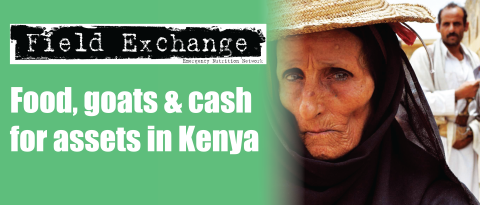en-net update, August to October 2012
By Tamsin Walters, en-net moderator

Forty-seven questions were posted on en-net in the three months August to October 2012 inclusive, eliciting 152 replies. In addition, 18 job vacancies and five notices were posted.
Recent discussions have included: appropriate treatment protocols using ready-to-use therapeutic food (RUTF) for older people with severe acute malnutrition (SAM), discharge criteria for Outpatient Therapeutic Programmes (OTPs), treatment of SAM in the absence of RUTF, how to interpret very low weight-for-height z-scores (WHZ) in nutrition surveys and whether to include them in analyses, assessing nutritional status of disabled children and establishing their nutritional requirements.
The Coverage assessment forum area has been busy since its inception almost a year ago. A particularly interesting dilemma was raised recently around handling cases that have been admitted to a community-based management of acute malnutrition (CMAM) programme with WHZ criteria, but a mid-upper arm circumference (MUAC) above 115mm and no oedema. In the situation in question, a SAM case was defined for the Semi- Quantitative Evaluation of Access and Coverage (SQUEAC) survey as MUAC < 115mm and/or presence of bilateral pitting oedema, while admission criteria to OTP included presence of bilateral pitting oedema, WHZ < -3 or MUAC < 115mm. The questioner was unsure as to whether a child admitted to the OTP using WHZ criteria should be considered a ‘recovering case’ or not a case at all in the coverage survey.
While responses presented different scenarios and reasoning for both inclusion and omission of the child from point coverage and period coverage calculations, there was consensus that the number of such children is likely to be very small in most surveys and therefore unlikely to greatly affect the overall coverage figure. However, an issue was raised as to whether it is appropriate to use a different case definition for admission into a programme as that for estimating coverage, as the coverage estimate does then not necessarily measure the same group of children who are enrolled in CMAM in the area. In programmes where nearly all admissions come from the community, assessed by MUAC and/or oedema, and there are very few WHZ admissions, there would probably be little impact on the coverage estimate. But in others it might be worthwhile confirming with programme data first that the proportion of children admitted to a CMAM programme based on WHZ is very small before excluding WHZ as a criterion in coverage assessment.
The discussion concluded with the observation that SQUEAC is a flexible methodology that can be adapted to different contexts, and a reminder that the main objective of SQUEAC is not to give a precise coverage figure but to examine and understand ‘barriers and boosters’ to achieving good coverage. Experience from coverage assessments to date suggests that coverage is generally low and this is not because of missing out the children admitted to programmes by WHZ, but because the community component of programmes is still weak. More attention and initiatives are needed to effectively address the community mobilisation aspects of programming.
To view the full discussion, go to http://www.en-net.org.uk/question/846.aspx
In response to growing interest and experience in the area of urban food security and nutrition, en-net has launched a new forum area on urban programming, http://www.en-net.org.uk/forum/14.aspx.
The first question focuses on: Urban malnutrition – what do we know?
Urban malnutrition data is very difficult to ascertain, because surveys do not differentiate between urban and rural, or because there is a view that rural areas are more vulnerable. In cases where urban malnutrition rates are reported there is often a failure to disaggregate data by poor areas and those that are better off, so that the specific vulnerabilities of disadvantaged groups are concealed. Please share your views on this, experiences or research findings at http://www.en-net.org.uk/question/873.aspx
Discussions will feature in a special ‘urban edition’ of Field Exchange planned in the first half of 2012 (Issue 46), see news piece this issue.
To join any discussion on en-net, share your experience or post a question, visit www.en-net.org.uk
Contributions from Freddy H, Mark Myatt, Lio Fieschi, Gwyneth, Jose Luis Alvarez, and Ernest Guevarra.
Imported from FEX website


